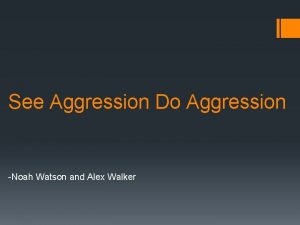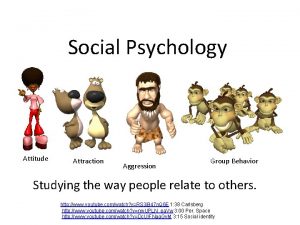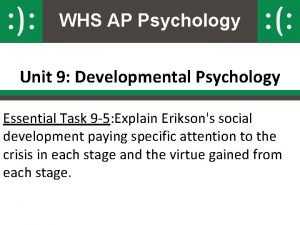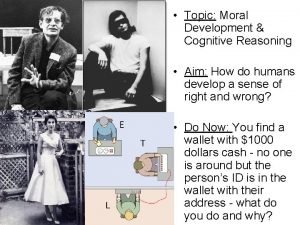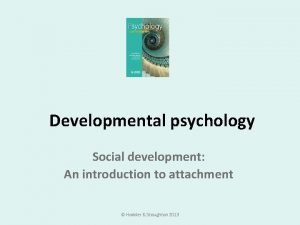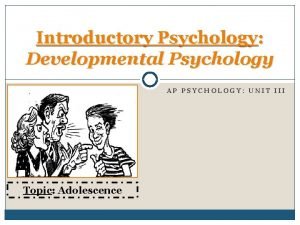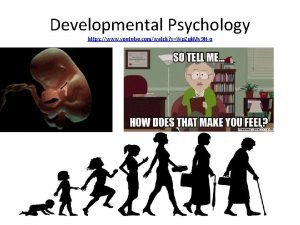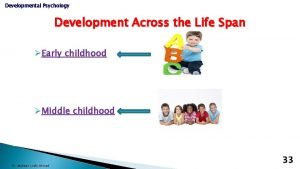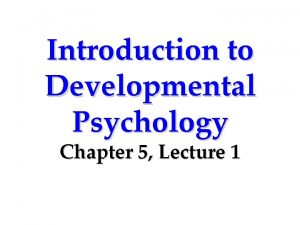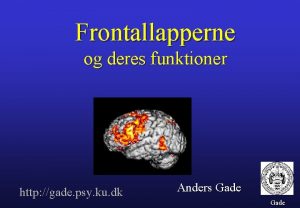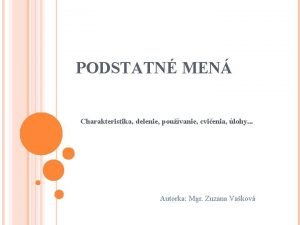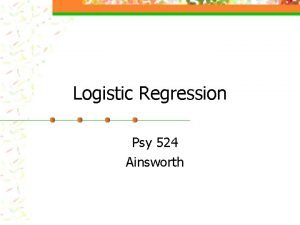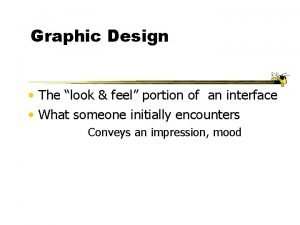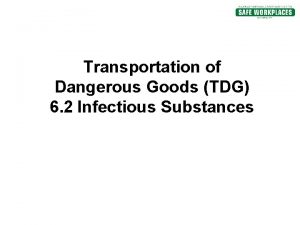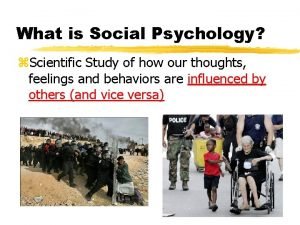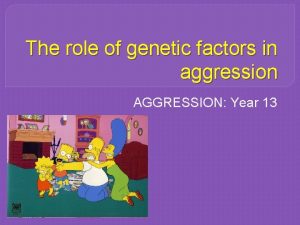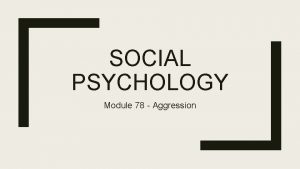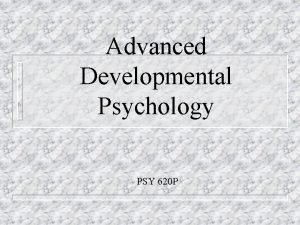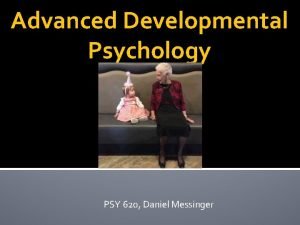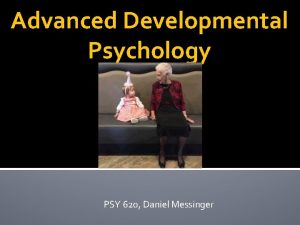Advanced Developmental Psychology PSY 620 P Overview Aggression



















































- Slides: 51

Advanced Developmental Psychology PSY 620 P

Overview �Aggression and development Relational and overt Reconciliation Video game effects �Adolescent adult activities declining �Adolescent risk-taking Adolescent effect (ventral striatum & cortex) Emotional stroop effect (Botdorf). Liz Adult presence mitigates

Stability of aggression �The earlier a person start, the more intense the form of aggression and the longer it lasts �Stability of aggression can be as high as. 76 Remarkably stable over up to 10 years The aggressive remain so �One of the more stable psychological characteristics �But developmentally variable

Behavior genetics �One inherits a propensity toward anti- sociality which interacts with an environment in its (non)emergence Genetic effects greater for self-reported than adjudicated measures of aggression ▪ Environmental, genetic, and interactive effects evident in petty crime

Disregard for conduct rules to parental power assertion to antisocial behavior in early preadolescence: Interplay with child’s skin conductance level � GRAZYNA KOCHANSKA, REBECCA L. BROCK, AND LEA J. BOLDT

Provocation aggression � Physically aggressive children exhibited hostile attributional biases and reported relatively greater distress for instrumental provocation situations Getting pushed into the mud � Relationally aggressive children exhibited hostile attributional biases and reported relatively greater distress for relational provocation contexts Not getting invited to a birthday party. 662 third- to sixth-grade children ▪ Crick et al. , 2002. CD.

Relational aggression � “Attempts to harm the victim through the manipulation of relationships, threat of damage to them, or both” (Crick et al, ’ 02 p. 98) � Associated with internalizing/externalizing problems and later peer rejection Preschool • Direct, face-to face behaviors • Exclusion from party Middle Childhood • More sophisticated, direct and indirect behaviors • Direct: refuse to choose as a team member • Indirect: spread a rumor Adolescence • Sophisticated and focused on opposite-sex relationships • Stealing a boyfriend


4 latent aggression factors: Physical, relational, proactive, & reactive �Physical, relational, proactive, and reactive Proactive and reactive positively correlated Physical and relational moderately associated �Forms stable but functions unstable over time �Proactive associated with increase in physical

Predictors of aggression at 4. 5 years

Aggression iarger context: Relational model Other possible ways are tolerance (e. g. , sharing of resources), or avoidance of confrontation (e. g. , by subordinates to dominants).

Most primates show a dramatic increase in body contact between former opponents during post conflict (PC) compared to matchedcontrol (MC) observations The cumulative percentage of opponentpairs seeking friendly contact during a 10 -min time window after 670 spontaneous aggressive incidents in a zoo group of stumptail macaques

If there is a strong mutual interest in maintenance of the relationship, reconciliation is most likely. Parties negotiate the terms of their relationship by going through cycles of conflict and reconciliation.

� 24 studies that assessed the link between VGV and later overt physical aggression Over 17, 000 participants Ages 9 to 19 years Time lags ranging 3 months to 4 years

VGV-aggression link � Prospective effect of VGV on subsequent aggression, controlling for baseline aggression. fixed [β = 0. 113, 95% CI = (0. 098, 0. 128)] random effects models [β = 0. 106 (0. 078, 0. 134)]. � Even after available covariate inclusion Fixed, β = 0. 080 (0. 065, 0. 094) Random, β = 0. 078 (0. 053, 0. 102)

Results VGV is associated with later overt physical aggression. Consideration of moderators Ethnicity Age Time lag Ethnicity=Whit e Ethnicity=Asi an Ethnicity=Hispan ic 0. 4 0. 2 0 -0. 2 Leung -0. 4



sex

Tried alcohol

When is an adolescent an adult? Assessing cognitive control in emotional and nonemotional contexts Cohen et al. , 2016 puccetti

Background � Adolescents (13 -17 yrs) display heightened sensitivity to motivational, social, and emotional information � Cognitive control in adolescents sometimes matches adults. . . But seems to be susceptible to incentive, threat, and peer influence � Cognitive performance within emotional contexts is especially relevant for policy (*18 -21) Juveniles tried as adults in US puccetti

Background • Should consider both behavioral and neural maturation to inform policy • Risky and impulsive adolescent behavior can be attributed to ‘dynamic and asymmetric’ brain development: • • Subcortical limbic structures: nonlinear trajectory with sensitization in adolescence PFC: linear trajectory of functional ‘growth’ that stabilizes in the 20’s puccetti

Behavioral paradigm Fearful Happy Calm CUES ~50 minutes ~10 sec per trial STATES � GO/NO GO = Press button when you see the TARGET 2 cues per state/block (GO stim/NO GO stim or TARGET/NONTARGET) � TARGET changed every block Calm = GO Fearful = NO GO Fearful = GO Happy = NO GO Etc. with all pairwise combos used puccetti

Age and performance in different emotion conditions (by gender) Results puccetti

Results d’ in response to fearful cues in the neutral state: Age differences : A > YA and T *did not survive when controlling for age d’ in response to calm cues in the threat state: age differences: A > YA > T *no regions survived whole brain correction puccetti

Adolescent Risk Taking Messinger & Halliday, 2021

Adolescent Risk Taking �Fewer adolescents engaging in adult behaviors (Twenge & Park, 2019) – maybe not inherently good or bad, but its not uniform ”An economically rich social context with higher parental investment in fewer children, greater life expectancy, fewer dangers from pathogens, and the expectation of tertiary education and later reproduction has produced a generation of young people who are taking on the responsibilities and pleasures of adulthood later than their predecessors” Halliday, 2021

Adolescent Risk Taking �Teens and young adults’ cognitive control differs from adults in brief and prolonged emotional conditions (Cohen et al. , 2016) �Lower SES/less supported teens and YAs experience more adult life stressors/ “pleasures” and have less cognitive control, especially under threatening and emotional situations Halliday, 2021

Botdorf et al. , 2017: Background � Teens take risks more often than children and adults Engaging in behaviors that may be high in subjective desirability (i. e. , associated with high sensation, novelty, or perceived reward) but exposes the individual to potential injury or loss (Geier & Luna, 2009) � The Dual Systems Model Incentive processing system (socio-emotional rewards) reaches peak reactivity during adolescence, while the cognitive control system (self-regulation, working memory and inhibitory control) matures more gradually Messinger & Halliday, 2021

Botdorf et al. , 2017: Background � Limited abilities to inhibit impulsive behaviors and weigh potential rewards/punishments during decision-making (Geier & Luna, 2009) � Heightened reward-seeking in the context of underdeveloped cognitive control = risk-taking � Vital implications for accidents, substance-use, suicide, etc. � Previous studies examining the association between cognitive control (impulsivity) and risk-taking in adolescents have yielded mixed results � In adolescents, the cognitive control system may function adequately under affectively neutral (cold) conditions, but becomes overwhelmed under affectively arousing (hot) conditions Messinger & Halliday, 2021

Botdorf et al. , 2017: Aims � Aim 1: Examine whether a task measuring cognitive control under an emotionally arousing condition could serves as a better predictor of individual differences in adolescent risktaking than a non-emotional cognitive task. � Aim 2: Examine gender (sex) differences. Based on data showing that males are more risky than females in real-world situations, and females process emotional information more quickly and accurately than their male counterparts. Messinger & Halliday, 2021

Methods � Participants 104 adolescents aged 13 -17 (M=15. 44) Recruited from a large metropolitan area 42. 3% males, 57. 7% females 63. 5% African American, 11. 5% Caucasian, 16. 3% Asian, 1% American Indian, 7. 7% Other/Not determined � Measures Cognitive Stroop task Emotional Stroop task NOTE: In contrast to the Cognitive Stroop, the Emotional Stroop did not have a time limit Risk-taking: Stoplight task Messinger & Halliday, 2021

The Stoplight driving task � As you approach intersection, light turns yellow Risk-taking = not braking for yellow light Messinger & Halliday, 2021

Results: Cognitive vs. Emotional � Stroop Interference Effect Participants responded more quickly (and accurately) on congruent than non-congruent trials, across the cognitive and emotional conditions – as expected � Emotional Stroop interference effect was significantly associated with risk-taking on the stoplight test (b), whereas Cognitive Stroop interference effect was not (a) � Only Emotional Stroop interference effect was significantly associated with risk taking when simultaneously examined with Cognitive Stroop interference effect in regression model Messinger & Halliday, 2021

Results: Gender Differences � No gender differences on Cognitive Stroop (speed, accuracy, interference) � Emotional Stroop Males were significantly less accurate and slower than females on incongruent trial No difference in interference effect � Risk taking on the Stoplight task No statistically significant difference � Males were slower and less accurate than females on the Emotional Stroop task, but comparable to females on Cognitive Stroop � Male’s Emotional Stroop performance more robustly predicted Stoplight risktaking (r =. 39, p <. 02) than did females’ performance (r =. 13, p =. 37). However, gender did not moderate the relationship between performance on the emotional Stroop task and the Stoplight task Messinger & Halliday, 2021

Conclusions � Individual differences in performance on the Emotional Stroop task, but not the Cognitive Stroop task, predicted risk taking in the Stoplight task Lower performance = more risks � Findings suggest, for the first time, that measuring cognitive control under affective arousal (“hot” conditions) may be a better predictor of individual differences in risk-taking than a task measuring cognitive control in a nonemotional context (“cold” conditions) � Results support the dual systems model and the idea that emotional context is vital to understanding the link between cognitive control and risk-taking in adolescents � Gender differences on the Emotional Stroop task support the notion that males exhibit a greater propensity to take dangerous risks, especially in the context of heightened emotional arousal. HOWEVER, no significant gender difference in Emotional Interference effect or Stoplight risktaking Messinger & Halliday, 2021

Discussion Questions � Do you think this pattern of findings is unique to adolescents? How could this be tested and what would results look like in children, adults? � How are the implications of these findings more detrimental for some adolescents more than others? � Individual differences in emotion regulation or traits? Differences in level of exposure to similar risky situations? � How might future studies extend these findings to better understand adolescent risk-taking in the real-world? Experimental design? Inclusion of a peer? � How might these findings inform efforts to reduce risky decision making in adolescents? � Unlike the Cognitive Stroop, there was no time limit for the Emotional Stroop. How might this have impacted the results? Messinger & Halliday, 2021

2011

Background �Incentive processing system ▪ The ventral striatum, orbitofrontal cortex, and others ▪ Decision making = valuation and predication of rewards/punishments ▪ Under re-organization during adolescence = heightened sensitivity to reward �Cognitive control system ▪ The lateral prefrontal cortex ▪ Decision making = goal-directed, keeping impulses in check ▪ Gradual and protracted development until early 20’s �Adolescence = heightened sensitivity to reward and under-developed impulse control

Lateral prefrontal cortex: cognitive control system ventral striatum, nucleus accumbens, and the orbitofrontal cortex: an incentive processing system

The Stoplight driving game � As you approach intersection, light turns yellow Chance crash or brake and wait Risk-taking = not braking for yellow light

Adolescent risks with peers While in the ‘Alone’ condition, self-reported… - Sensation seeking predicted greater risky driving behavior - Impulsivity did not predict risky driving behavior

f. MRI Results

Borenstein

Hypotheses � The presence of a somewhat older adult mitigates the peer effect on adolescents’ risk taking This mitigation is explained by attenuation of the impact of peers on adolescents’ preference for immediate rewards Borenstein

Methods � Funded by the U. S. Army How best to group soldiers in combat teams � Males in late adolescence recruited from colleges in Philadelphia, PA Other subjects recruited via Temple University’s intro psychology classes 18 -22 years of age � 3 social-context situations Solo- tested alone Peer-group- observed by 3 same-age peers Adult-present- 2 same-age peers and 25 -30 year old confederate Borenstein

Measures � Risk Taking – Stop light computerized driving task Goal to reach end of track as quickly as possible 32 intersections with yellow lights ▪ Decide whether to stop vehicle via spacebar and lose time, or go through the intersection with possibility of crash Proportion of intersections crossed w/out stopping = risk Subjects and observers told about $15 bonus for performance � Preference for Immediate Rewards – Delay discounting task Small immediate reward vs. large delayed reward Delayed reward constant at $1, 000 ▪ Delay interval (1 wk, 1 mo, 6 mo, 1 yr, 5 yrs, 15 yrs) (randomized) Immediate reward = $200, $500, or $800 (randomized) Nine choices presented in succession – previously chosen rewards cut in half for next choice (e. g. , delayed choice= $1, 000 -> next delayed option = $500) Ending value reflects discounted value of the delayed reward (average indifference point) Borenstein

The presence of an adult mitigates risk-taking � Peer group subjects took significantly more risks in the game, when compared to solo (p<. 001) and adult present conditions (p<. 002) Subjects in the adult present condition did not differ from the solo condition (p=. 83) Borenstein

Adult presence reduces peer influence on immediate reward preference � Peer group -- lower indifference point Significantly different than solo Marginally different than adultpresent � Discount rates paralleled indifference points Higher discount rate= greater orientation towards an immediate reward Peer group exhibited significantly greater discount rate, compared to solo and adult-present � No differences between solo and adult-present groups for indifference points and discount rates Borenstein

Discussion � Male adolescents took more risks and expressed stronger preferences for immediate rewards when grouped with same age/sex peers � Adding a male mid-late 20’s can mitigate these effects � Adults influence the effect of peers on adolescent risk taking, through dampening increased activities in the brain’s reward centers � Risky choice to express bravado among peers � Safe choice to appear more prudent in presence of adult Borenstein
 See aggression do aggression
See aggression do aggression See aggression do aggression
See aggression do aggression Mauritania white moors
Mauritania white moors Types of aggression in psychology
Types of aggression in psychology Unit 9 developmental psychology
Unit 9 developmental psychology Lawrence kohlberg developmental psychology
Lawrence kohlberg developmental psychology Research methods in developmental psychology
Research methods in developmental psychology Wilhelm wundt structuralism
Wilhelm wundt structuralism Attachment developmental psychology
Attachment developmental psychology Adolescent age range psychology
Adolescent age range psychology Devonte is a graduate student in developmental psychology
Devonte is a graduate student in developmental psychology Authoritariam
Authoritariam Ucf psychology department
Ucf psychology department Regression
Regression Characteristics of social development
Characteristics of social development Chapter 5 developmental psychology
Chapter 5 developmental psychology Euro psy
Euro psy Psy2055
Psy2055 Psy 2055
Psy 2055 Xxxxblue
Xxxxblue Psy
Psy Psy sanin
Psy sanin Psy
Psy Psy 421
Psy 421 Phonological loop
Phonological loop Psy
Psy Psy 226
Psy 226 Psy
Psy Psy academy
Psy academy Damasio
Damasio Psy walsh
Psy walsh Sluzobne plemena psov
Sluzobne plemena psov Túlavé psy vzor
Túlavé psy vzor 11 psy
11 psy Regression psy
Regression psy Psy
Psy Psy 335 purdue
Psy 335 purdue Un1845 packing instruction
Un1845 packing instruction 12vac35-105-620
12vac35-105-620 Toefl 620
Toefl 620 Here is where your presentation begins artinya
Here is where your presentation begins artinya Trigo sy 120 ciclo
Trigo sy 120 ciclo Jms 620
Jms 620 Dd160 emc
Dd160 emc Mdcrs
Mdcrs Meam 620
Meam 620 Aruba 620 controller
Aruba 620 controller Julius caesar vs augustus
Julius caesar vs augustus Isa 620 using the work of an expert
Isa 620 using the work of an expert Krs 620
Krs 620 Social inhibition
Social inhibition Discuss the role of genetic factors in aggression
Discuss the role of genetic factors in aggression

